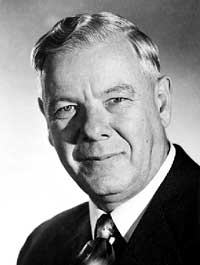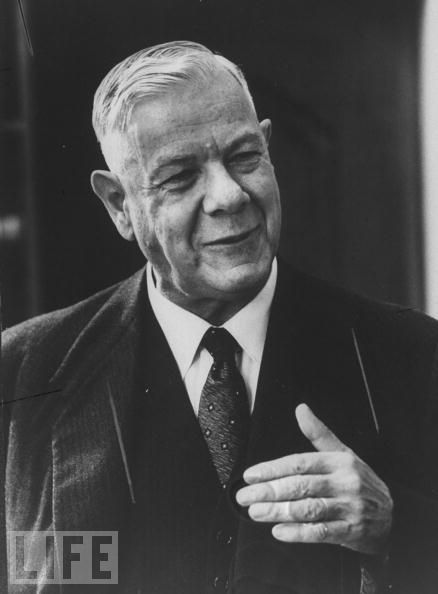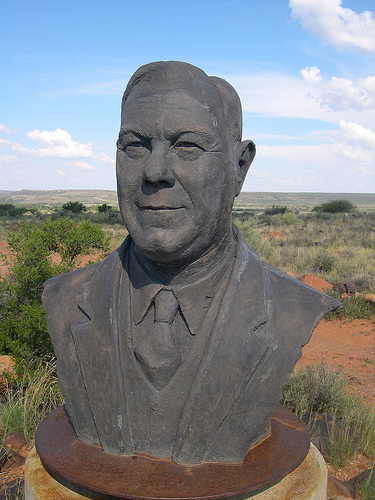<Back to Index>
- Jurist and Chancellor of Germany Georg Michaelis, 1857
- Composer Jaime Nunó Roca, 1824
- 7th Prime Minister of South Africa Hendrik Frensch Verwoerd, 1901
PAGE SPONSOR



Hendrik Frensch Verwoerd (8 September 1901 – 6 September 1966) was Prime Minister of South Africa from 1958 until his assassination in 1966.
He was Prime Minister during the establishment of the Republic of South Africa in 1960, thereby fulfilling the Afrikaner dream of an independent republic for South Africans. During his tenure as Prime Minister, anti - Apartheid movements such as the African National Congress (ANC) and Pan Africanist Congress were banned, and the Rivonia Trial, which prosecuted the struggle's leaders, was held.
Numerous major roads, places and facilities in towns and cities in South Africa were named after Verwoerd, like the H.F. Verwoerd Airport in Port Elizabeth, the Verwoerd Dam in the Free State, the H.F. Verwoerd Academic Hospital in Pretoria, and the town of Verwoerdburg. In post - apartheid South Africa, most of them have been renamed. Verwoerd was born in the Netherlands.
He was the second child of Anje Strik and Wilhelmus Johannes Verwoerd:
he had an elder brother named Leendert and a younger sister named
Lucie. His father was a shopkeeper and a deeply religious man who
decided to move his family to South Africa in 1903 because of his
sympathy towards the Afrikaner nation after the Second Boer War. In 1913, the family moved to Bulawayo, Southern Rhodesia, where the elder Verwoerd became an assistant evangelist in the Dutch Reformed Church.
Hendrik Verwoerd attended Milton High School where he was awarded the
Beit Scholarship, but was forced to decline because of his family’s move
back to South Africa, Brandfort in the Orange Free State. Due to the worldwide spanish flu epidemic, Hendrik Verwoerd sat for his matriculation exams in February 1919,
proving himself to be an able student at the Lutheran School in Wynberg
and Wynberg Boys' High School, achieving first position in the Orange Free State and fifth in South Africa. After his schooling, he proceeded to study theology at the University of Stellenbosch, later changing to psychology and philosophy. He was awarded a masters and a doctorate in Psychology, both cum laude, and turned down an Abe Bailey scholarship to Oxford University, England, opting to continue his studies in psychology and theology in
Germany. Verwoerd left for Germany in 1925, and stayed there during
1926, studying at the Universities of Hamburg, Berlin and Leipzig. His
later critics have at times suggested that this coincided with the rise
of German National Socialism in
the 1930s; however, according to the 'Dictionary of South African
Biography' of 1981, his stay predated it by a number of years. It has
been speculated that he met with Eugen Fischer during his stay, but at this stage, Social Darwinism was not the focus of Verwoerd's research. He published a number of works dating back to that time. Dr. Hendrik Verwoerd's fiancee, Betsie Schoombie, joined him in Germany and they were subsequently married on 7 January 1927 in Hamburg.
Later that year, he continued his studies in Britain and then in the
United States of America. His lecture notes and memoranda at Stellenbosch stressed
that there were no biological differences between the big racial
groups, and concluded that "this was not really a factor in the
development of a higher social civilisation by the Caucasians." He
published a number of works dating back to his time in Germany: "A
method for the experimental production of emotions" (1926); "'n
Bydrae tot die metodiek en probleemstelling vir die psigologiese
ondersoek van koerante - advert" ("A contribution on the psychological
methodology of newspaper advertisement") (1928); "The distribution of
'attention' and its testing" (1928); "Effects of fatigue on the
distribution of attention" (1928); "A contribution to the experimental
investigation of testimony" (1929?); "Oor die opstel van objektiewe
persoonlikheidsbepalingskemas" ("Objective criteria to determine
personality types") (1930?); "Oor die persoonlikheid van die mens en
die beskrywing daarvan" ("On the human personality and the description
thereof") (1930?) Verwoerd returned with his wife to South Africa in 1928 and was appointed to the chair of Applied Psychology at the University of Stellenbosch where, six years later, he became Professor of Sociology and Social Work. During the Great Depression, Verwoerd became active in social work among
poor White South Africans. He devoted much attention to welfare work
and was often consulted by welfare organisations, while he served on
numerous committees. His
efforts in the field of national welfare drew him into politics and in
1936 he was offered the first editorship of ‘Die Transvaler’, a
position which he took up in 1937, with the added responsibility of
helping to rebuild the National Party of South Africa (NP) in the Transvaal. Die Transvaler was a publication which supported the aspirations of Afrikaner nationalism, agricultural and labour rights. Combining republicanism, populism and protectionism,
the paper helped "solidify the sentiments of most South Africans, that
changes to the socio - economic system were vitally needed". The South African general election of 1948 was
held on the 26 May 1948 and saw the Nationalist Party win the general
election. Running on the platform of self - determination and apartheid as
it was termed for the first time, Prime Minister Daniel Malan and his party benefited from their support in the rural electorates, defeating General Jan Christiaan Smuts and his United Party. General Smuts lost his own seat of Standerton.
Most party leaders agreed that the nationalist policies were
responsible for the National Party's victory. To further cement their
nationalist policies, Herenigde Nasionale Party leader Daniel Malan
called for stricter enforcement of job reservation protecting the rights
of the White working class, and the rights of White workers to organise
their own labour unions outside of company control. Hendrik Verwoerd was elected to the Senate later
that year, and became the minister of native affairs under Prime
Minister Malan in 1950, until his appointment as prime minister in 1958.
In that position, he helped to implement the Nationalist Party's
program. Among the laws which were drawn and enacted during Verwoerd's time as minister for native affairs were the Population Registration Act and the Group Areas Act in 1950, the Pass Laws Act of 1952 and the Reservation of Separate Amenities Act of 1953. Prime Minister Daniel Malan announced his retirement from politics following the NP's success in the elections of 1953. In the succession debate that followed Dr. Malan's retirement, N.C. Havenga, Theophilus Ebenhaezer Dönges and Verwoerd were potential successors. The strongest candidate J.G. Strijdom eventually was nominated Prime Minister. Dr. Hendrik Verwoerd gradually gained popularity with the Afrikaner electorate
and continued to expand his political support. With his overwhelming
constituency victory in the 1958 election and the death shortly
thereafter of Prime Minister J.G. Strijdom, Verwoerd was appointed by
the Governor - General to organise a Government as Prime Minister. Hendrik Verwoerd is often called the "Architect of Apartheid for his role in shaping the implementation of apartheid policy
when he was Minister of Native Affairs and then Prime Minister.
Verwoerd once described apartheid as a "policy of good neighbourliness". Afrikaner
nationalism was skilfully mobilised by leaders in the theological,
political, cultural, economic, agricultural and industrial sectors as
well as in government service. A strategy of massive economic
development was introduced to make South Africa less dependent on
Britain and to create thousands of job opportunities. Verwoerd
realised that the political situation that evolved over the previous
century under British rule in South Africa had become untenable. Under the Premiership of Dr. Verwoerd the following legislative acts relating to apartheid were introduced: The creation of a Republic was one of the National Party's long term goals since originally coming to power in 1948. In
January 1960, Verwoerd announced that a referendum would be called to
determine the Republican issue, the objective being a republic within
the Commonwealth. Two weeks later, Harold Macmillan, then British Prime Minister, visited South Africa. In an address to both Houses of Parliament he made his famous Winds of Change speech, which was interpreted as an end to British support for White rule. In
order to bolster support for a republic, the voting age for Whites was
lowered from twenty-one to eighteen, benefiting younger Afrikaans
speakers, who were more likely to favour a republic, and the franchise
was extended to whites in South West Africa, most of whom were German or Afrikaans speakers. The referendum was
accepted by Parliament and was held on 5 October 1960, in which voters
were asked, "Are you in favour of a Republic for the Union?" 52 percent
voted 'Yes'. The
Republic of South Africa came into existence on 31 May 1961, this
significant date was chosen because it was the anniversary of the
signing of the Treaty of Vereeniging that had brought the Second Boer War to an end in 1902. The last Governor - General, Charles Robberts Swart, took office as the first State President. Following India's assumption of a republican status, it was agreed by Commonwealth leaders that being a Republic was not incompatible with membership, but that a Commonwealth Realm would have to reapply for Commonwealth membership if it became a Republic. After South Africa became a republic, Verwoerd refused to accept black ambassadors from Commonwealth states. On 9 April 1960, Dr. Hendrik Verwoerd opened the Union Exposition on the Witwatersrand to mark the jubilee of the Union of South Africa. David Pratt, a South African farmer from Natal attempted
to assassinate Dr. Verwoerd, firing two shots from a .22 automatic
pistol at point blank range, one bullet perforating his right cheek and
the second his right ear. Colonel
G.M. Harrison, president of the Witwatersrand Agricultural Society,
leapt up and knocked the pistol from the gunman's hand. After the pistol
fell to the floor, Colonel Harrison, with the help of Major Carl
Richter, the Prime Minister's personal bodyguard, civilians and another
policemen overpowered the gunman and hustled him to the show grounds
Police Station. The arrest was made so quickly and the removal was done
so quickly that an angry section of the crowd was frustrated from
assaulting the detainee. The detainee, David Pratt, was soon thereafter
hurried to Marshall Square police station. Within
minutes of the assassination attempt, Dr. Verwoerd was rushed – still
conscious – to the Pretoria Hospital. Two days later, the hospital
issued a statement which described his condition as 'indeed satisfactory
– further examinations were carried out today and they confirm good
expectations. Dr. Verwoerd at present is restful. There is no need for
any immediate operation.' The surgeons who worked on Dr. Verwoerd would
later claim that his escape had been 'absolutely miraculous'. Specialist
surgeons were called in to remove the bullets. At first, there was
speculation that Dr Verwoerd would lose his hearing and sense of
balance, but this was to prove groundless. He returned to public life
on 29 May, less than two months after the shooting. David Pratt appeared in the Johannesburg Magistrates'
Court on 11 April. He was described as a 'socialite and farmer'. He was
a respected member of the Witwatersrand Agricultural Society and had
been close to Verwoerd on a number of occasions prior to the shooting.
In fact, it was later revealed that Pratt had been one of the VIPs
sitting next to Dr Verwoerd during the opening of the exposition. Pratt,
who claimed he had been shooting 'the epitome of apartheid', was
eventually declared ‘mentally disordered and epileptic'. On 26 September 1960, he was committed to Pretoria Central Prison to
'await indication of the Governor General's pleasure'. On 1 October
1961, he hanged himself at Bloemfontein Mental Hospital. The National Party under Verwoerd won the 1966 general election.
During this period, the National Party government continued to foster
the development of a military industrial complex, that successfully
pioneered developments in native armaments manufacturing including
aircraft, small arms, armoured vehicles, and even nuclear and biological weapons. Three days before his death, Verwoerd had held talks with the Prime Minister of Lesotho, Chief Leabua Jonathan, at the Union Buildings in Pretoria. Following
the meeting, a joint communique was issued by the two governments with
special emphasis on "co-operation without interference in each others'
internal affairs". On 6 September 1966, Verwoerd was assassinated in Cape Town, shortly after entering the House of Assembly at 2:15 pm. A uniformed parliamentary messenger named Dimitri Tsafendas stabbed Verwoerd in the neck and chest four times before being subdued by other members of the Assembly. Members who were also trained as medical practitioners rushed to the aid of Verwoerd and started administering cardiopulmonary resuscitation. Verwoerd was rushed to Groote Schuur Hospital, but was declared dead upon arrival. Tsafendas
escaped the death penalty on the grounds of insanity. Judge Beyers
ordered Tsafendas to be imprisoned indefinitely at the "State
President's pleasure." Verwoerd's funeral, attended by a quarter of a million people, was held in Pretoria on 10 September 1966. He was buried in the Hero's Acre in front of the Union Buildings. The
still blood - stained carpet where Hendrik Verwoerd lay after the
murder remained in Parliament until it was removed in 2004. The town of Orania in
the Northern Cape province houses the Verwoerd collection – memorabilia
collected during Dr Verwoerd’s lifetime and now on display in the house
where his widow lived for the last years before her death in 2001.
In 1961, UN Secretary - General Dag Hammarskjöld stopped over in South Africa and subsequently stated that he had been unable to reach agreement with Prime Minister Verwoerd. On 6 November 1962, the United Nations General Assembly passed Resolution 1761, condemning South African apartheid policies. On 7 August 1963, the United Nations Security Council passed Resolution 181 calling for a voluntary arms embargo against
South Africa, and in the same year, a Special Committee Against
Apartheid was established to encourage and oversee plans of action
against the regime. From 1964, the US and Britain discontinued their arms trade with South Africa. Economic
sanctions against South Africa were also frequently debated in the UN
as an effective way of putting pressure on the apartheid government. In
1962, the UN General Assembly requested that its members sever
political, fiscal and transportation ties with South Africa.